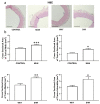Elevated Vascular Sympathetic Neurotransmission and Remodelling Is a Common Feature in a Rat Model of Foetal Programming of Hypertension and SHR
- PMID: 36009448
- PMCID: PMC9405620
- DOI: 10.3390/biomedicines10081902
Elevated Vascular Sympathetic Neurotransmission and Remodelling Is a Common Feature in a Rat Model of Foetal Programming of Hypertension and SHR
Abstract
Hypertension is of unknown aetiology, with sympathetic nervous system hyperactivation being one of the possible contributors. Hypertension may have a developmental origin, owing to the exposure to adverse factors during the intrauterine period. Our hypothesis is that sympathetic hyperinnervation may be implicated in hypertension of developmental origins, being this is a common feature with essential hypertension. Two-animal models were used: spontaneously hypertensive rats (SHR-model of essential hypertension) and offspring from dams exposed to undernutrition (MUN-model of developmental hypertension), with their respective controls. In adult males, we assessed systolic blood pressure (SBP), diastolic blood pressure (DBP), heart rate (HR), sympathetic nerve function (3H-tritium release), sympathetic innervation (immunohistochemistry) and vascular remodelling (histology). MUN showed higher SBP/DBP, but not HR, while SHR exhibited higher SBP/DBP/HR. Regarding the mesenteric arteries, MUN and SHR showed reduced lumen, increased media and adventitial thickness and increased wall/lumen and connective tissue compared to respective controls. Regarding sympathetic nerve activation, MUN and SHR showed higher tritium release compared to controls. Total tritium tissue/tyrosine hydroxylase detection was higher in SHR and MUN adventitia arteries compared to respective controls. In conclusion, sympathetic hyperinnervation may be one of the contributors to vascular remodelling and hypertension in rats exposed to undernutrition during intrauterine life, which is a common feature with spontaneous hypertension.
Keywords: fibrosis; foetal programming of hypertension; foetal undernutrition; sympathetic innervation; sympathetic neurotransmission; vascular remodelling.
Conflict of interest statement
The authors declare no conflict of interest.
Figures







Similar articles
-
Vascular angiotensin AT1 receptor neuromodulation in fetal programming of hypertension.Vascul Pharmacol. 2019 Jun;117:27-34. doi: 10.1016/j.vph.2018.10.003. Epub 2018 Oct 13. Vascul Pharmacol. 2019. PMID: 30326265
-
Role of fetal nutrient restriction and postnatal catch-up growth on structural and mechanical alterations of rat aorta.J Physiol. 2018 Dec;596(23):5791-5806. doi: 10.1113/JP275030. Epub 2018 Jan 31. J Physiol. 2018. PMID: 29277911 Free PMC article.
-
Hypernoradrenergic innervation: its relationship to functional and hyperplastic changes in the vasculature of the spontaneously hypertensive rat.Blood Vessels. 1989;26(1):1-20. Blood Vessels. 1989. PMID: 2540863 Review.
-
Increased sympathetic innervation in the cerebral and mesenteric arteries of hypertensive rats.Can J Physiol Pharmacol. 1990 Apr;68(4):492-9. doi: 10.1139/y90-070. Can J Physiol Pharmacol. 1990. PMID: 2328451
-
The spontaneously hypertensive rat: insight into the pathogenesis of irritative symptoms in benign prostatic hyperplasia and young anxious males.Exp Physiol. 1999 Jan;84(1):137-47. doi: 10.1111/j.1469-445x.1999.tb00079.x. Exp Physiol. 1999. PMID: 10081714 Review.
Cited by
-
Slower Growth during Lactation Rescues Early Cardiovascular and Adipose Tissue Hypertrophy Induced by Fetal Undernutrition in Rats.Biomedicines. 2022 Oct 7;10(10):2504. doi: 10.3390/biomedicines10102504. Biomedicines. 2022. PMID: 36289765 Free PMC article.
-
Advances on the Experimental Research in Resistant Hypertension.Curr Hypertens Rep. 2024 Dec;26(12):475-482. doi: 10.1007/s11906-024-01315-2. Epub 2024 Jul 18. Curr Hypertens Rep. 2024. PMID: 39023702 Review.
-
Chronic rose oxide and exercise synergistically modulate cardiovascular and autonomic functions in hypertensive rats.Pflugers Arch. 2025 Feb;477(2):241-251. doi: 10.1007/s00424-024-03035-7. Epub 2024 Oct 30. Pflugers Arch. 2025. PMID: 39476259
References
-
- van der Linden E.L., Collard D., Beune E.J.A.J., Nieuwkerk P.T., Galenkamp H., Haafkens J.A., van Charante E.P.M., van den Born B.-J.H., Agyemang C. Determinants of suboptimal blood pressure control in a multi-ethnic population: The Healthy Life in an Urban Setting (HELIUS) study. J. Clin. Hypertens. 2021;23:1068–1076. doi: 10.1111/jch.14202. - DOI - PMC - PubMed
Grants and funding
LinkOut - more resources
Full Text Sources

